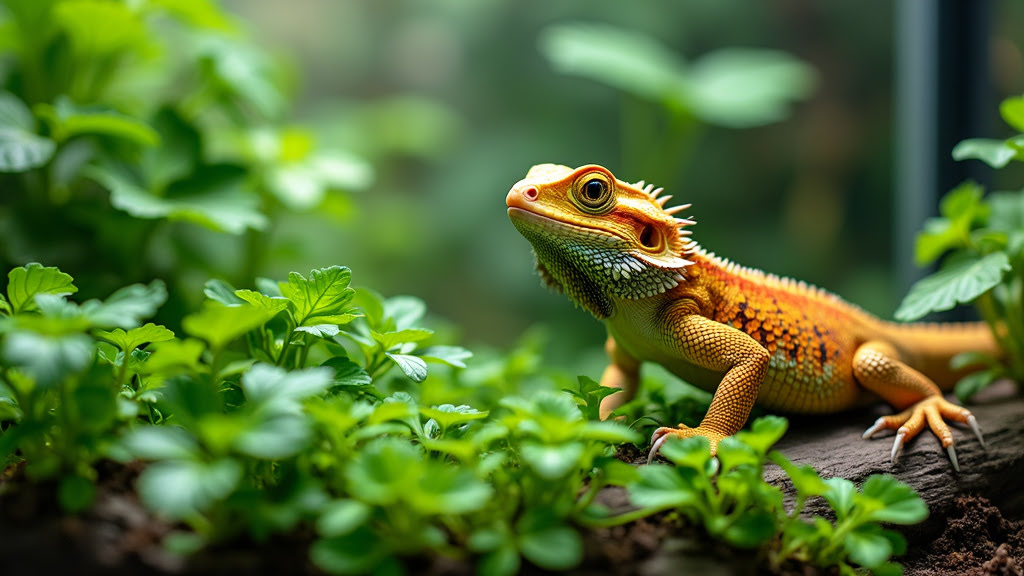Welcome back to Dug’s Bugs! Today, we’re going to talk about bearded dragons and what they eat, especially about a leafy green called watercress. But before we jump into watercress, let’s learn a bit about what bearded dragons love to eat.
Understanding Bearded Dragon Diets
Bearded dragons are interesting animals that eat different kinds of food. These reptiles like to eat both insects and plants. Young dragons need more protein from insects, but adult dragons need more greens and vegetables.
When I first got my bearded dragon, Spike, figuring out what to feed him was like a puzzle. But with some research and trying different foods, I found the right mix to keep him healthy and happy.
Nutritional Profile of Watercress
Watercress is a leafy vegetable rich in vitamins A, C, and K, and also has calcium and iron. People often eat it in salads, soups, and sandwiches because of its peppery flavor and health benefits. But can bearded dragons eat watercress too?
Is Watercress Safe for Bearded Dragons?

Yes, bearded dragons can eat watercress! It is safe and compares well to other leafy greens like collard greens or mustard greens. But remember, moderation is key.
Watercress can be a yummy part of their diet but shouldn’t be the main food. It’s important to offer a variety of foods to meet all their nutritional needs. Spike really likes a nibble of watercress once in a while!
Comparing Watercress to Other Leafy Greens
- Collard Greens: Rich in calcium and fiber, great for regular feeding.
- Mustard Greens: High in calcium and vitamins A and C.
- Dandelion Greens: Nutritious but has some oxalates, so feed in moderation.
In my experience, giving different greens keeps Spike’s diet balanced and meal times interesting.
Safe Vegetables for Bearded Dragons
Offering a mix of vegetables is crucial for your bearded dragon’s health. Here’s a list of recommended veggies:
- Collard Greens: High in calcium and low in oxalates, great as a staple.
- Mustard Greens: Packed with vitamins and a spicy taste that dragons love.
- Dandelion Greens: Nutritious but feed in moderation.
- Butternut Squash: High in beta carotene, which converts to vitamin A.
Rotating these vegetables keeps your pet happy and well-fed. Just like us, dragons enjoy variety!
How to Prepare Watercress for Your Bearded Dragon
Preparing watercress for your bearded dragon is easy. Follow these steps:
Step-by-Step Guide
Step 1: Washing
Wash the watercress thoroughly to remove any dirt or pesticides. Fresh and pesticide-free is best!
Step 2: Cutting
Cut the watercress into small, bite-sized pieces. This makes it easier for your dragon to eat and digest.
Step 3: Serving
Serve the watercress with other greens and vegetables in a mixed salad. Variety keeps their diet balanced.
Just like we wouldn’t eat a whole cabbage in one meal, portion control is important! Feeding too much of one vegetable can unbalance their diet.
Potential Risks and Health Concerns
While watercress is mostly safe, too much can cause problems because of its high calcium and oxalate levels. Watching your dragon’s diet and offering a variety of foods can prevent these issues.
If your bearded dragon shows signs of diarrhea or tiredness, it might be a dietary problem. Spike once ate too much dandelion greens, and it wasn’t pretty! Consult a vet if you notice any unusual behavior or health issues. They know best when it comes to your pet’s health.
Creating a Balanced Meal Plan
Planning meals for your bearded dragon can be fun! A balanced diet includes both protein and vegetables. Here are some sample schedules to help you:
Sample Daily Schedule
- Morning: A handful of mixed greens like watercress, collard greens, and butternut squash.
- Afternoon: Protein such as crickets or mealworms.
- Evening: A smaller portion of greens and sometimes fruit.
Weekly Rotation
- Monday: Mustard greens and crickets.
- Tuesday: Dandelion greens and mealworms.
- Wednesday: Collard greens and Dubia roaches.
- Thursday: Watercress and squash mix.
- Friday: Mustard greens and crickets.
- Saturday: Dandelion greens and mealworms.
- Sunday: A mix of all greens with a fruit treat.
By changing the greens and proteins each week, you make sure your bearded dragon gets all the nutrients they need.
Conclusion
Adding watercress to your bearded dragon’s diet can be good but should be done in moderation. The key is variety and balance to make sure they get all the nutrients they need. Watching your pet and talking to a vet will help you make the best choices.
We love hearing from our Dug’s Bugs community! Do you have any tips or stories about feeding watercress or other greens to your bearded dragon? Share your comments below and let’s keep this conversation going.
References
While this post is based on my experiences and having Spike as my inspiration, always check reliable sources such as RSPCA and expert advice for a deeper understanding of your pet’s dietary needs!
Happy feeding, and may your bearded dragons thrive!




